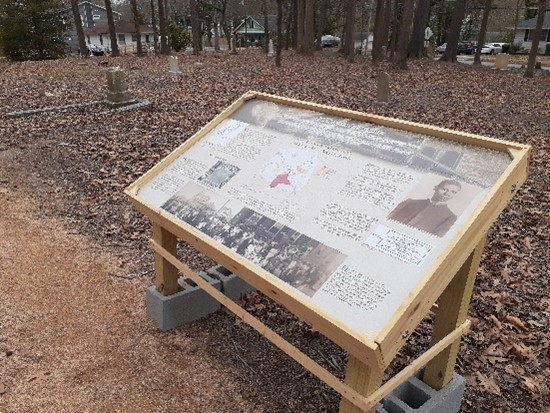(Hi)Stories In The Time of Plague

Geer Cemetery currently hosts an on-site exhibit, In Plain Sight, which features histories and stories of the people buried in the cemetery and of their communities. The exhibit is open for self-guided tours as described in the exhibit website. Docent-led tours are completely booked for the weeks the exhibit is scheduled to be open. During a break in the weeks of rain Durham had this February, I stopped by Geer Cemetery to view a sign that I’d built remotely for the exhibit. Across the cemetery, I noticed a man, a woman, and two children making their way along the carriage path that leads from one exhibit display to another. As the group finished their visit, the man called to me from his car and asked if I was “part of this,” waving his hand back toward the displays. Through my mask, I answered that I was wondering how I could let him know something of the enormous amounts of time and energy that others in the Friends of Geer Cemetery had put in to produce the exhibit and how my connection to that work was recent and minor. He said, “this is really great,” and seemed to want to say more but wasn’t sure exactly what. I asked what had he taken away from the exhibit? “The stories. The stories of the people, and everything they did and their lives.”
Feeling like a bit of an evangelist, I thanked him for visiting and encouraged him to tell others about the exhibit and the cemetery. As I prepared to leave, one car — and then another — stopped on Camden Avenue, and their drivers asked me if this was a cemetery and what was going on. I told each a few sentences about the cemetery and the exhibit and both said they planned to come back to learn more. Driving away, I wondered at the energy of these socially distanced encounters, mediated across two layers of masked isolation and considered that in these pandemic days we may be especially hungry to engage and share stories.
A few years ago, I had the joy of a semester-long graduate seminar on one book, Giovanni Boccaccio’s The Decameron, set in and around Florence, Italy, during the plague year of 1348. In the framing tale of the book, a group of ten friends retreat from the contagious density of Florence, isolates themselves in what we might today call a pod, and tells each other stories. The friends’ storytelling is highly structured, with a different person in charge of the day to determine the order in which each storyteller will share. Through those structures and stories, they explore their relationships with their cultural institutions, their society’s expectations of and limitations on them, and their own inner worlds, even as they detach from their society for safety reasons. The stories upend conventions, are sometimes irreverent, and can open ways for readers to consider themselves by fresh lights.

As we deal with our own year filled with news of a plague and devoid of opportunities to experience stories communally, I imagine that a place dedicated for a time, as Geer Cemetery currently is, to stories and histories is exactly what we need. We too, in our public discourse, seem eager to see ourselves by new lights and reconsider social ills that have plagued us for many generations.
Continuing and expanding those stories, a new body of work compiled by the Friends of Geer Cemetery takes a quantitative and comprehensive look at what we so far know of the people interred in the cemetery. This work will assist descendants and scholars alike who want to find stories of individual people and to consider demographic dimensions of the occupants of the cemetery. Sorting these data by cause of death, I am surprised to see only four and five known cases of pneumonia during the plague years of 1918 and 1919, respectively. Duke scholar Dr. Kaylee Alexander has organized this new work and developed tools for analysis and exploration. But, as she cautions, the ways we structure our engagement with these materials are worth considering too. “One recurring critique of using data in the humanities, and particularly of using data to talk about individuals who have historically been dehumanized, is that these methods further anonymize and dehumanize.”
And here I wonder if I’m closer to understanding the interest and energies I sensed on my brief stop at the cemetery. The In Plain Sight exhibit puts visitors at or near the graves of people it features, and it portrays those people and their communities in ways that humanize and personalize them. Especially during a pandemic when our human connections are strained and stressed, we may be hungrier than usual for such connections and to make those connections in a public space and with a sense of community. So, I appreciate even more the ongoing work of the Friends of Geer Cemetery. Not only do their efforts to “reclaim, restore, and respect” Geer Cemetery help Durham consider and come to terms with its social trajectories across many generations, these efforts may also help sustain us during a time of isolation and plague.
